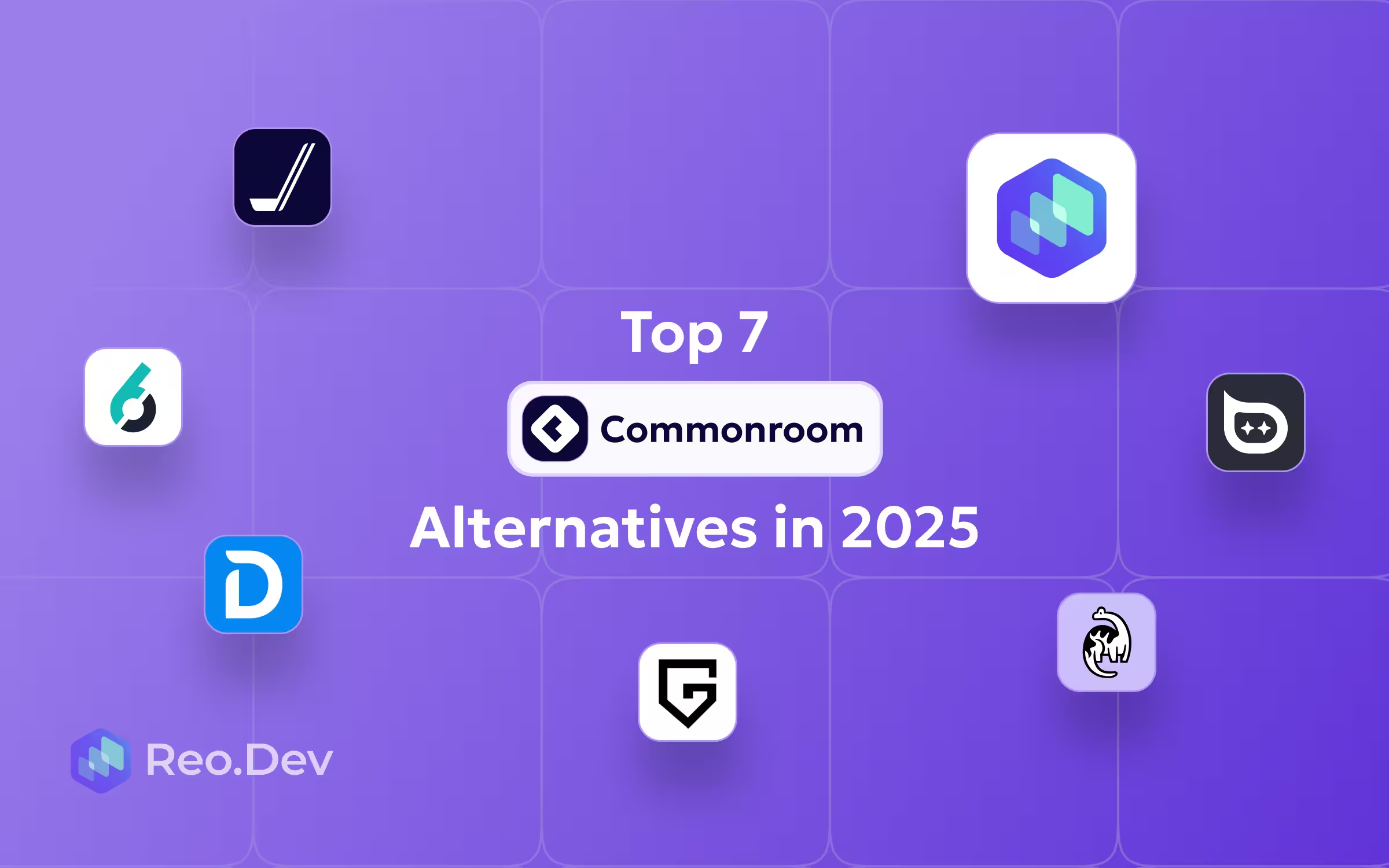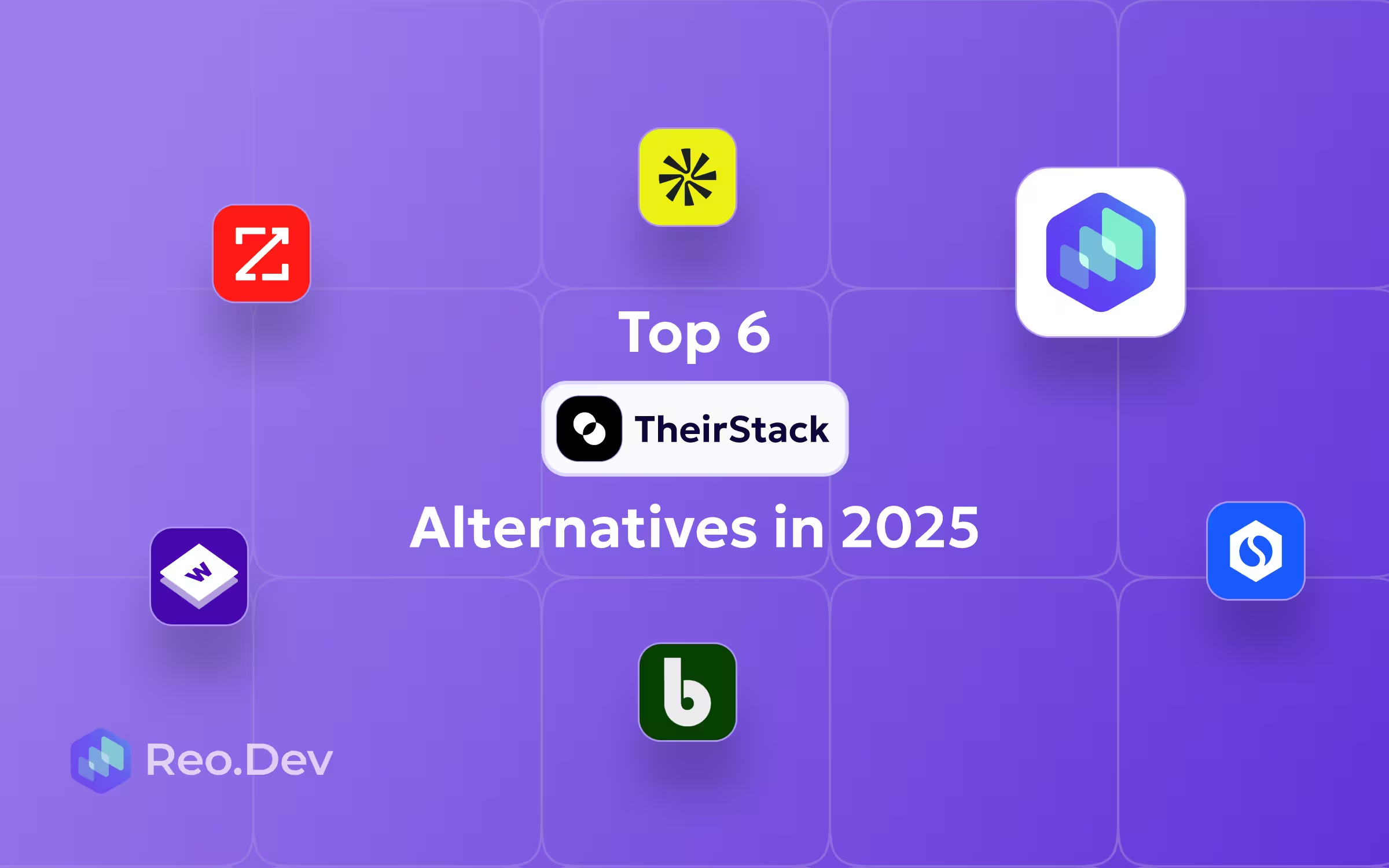Common Room is best for SaaS companies that are primarily community-first, have mid-to-large teams with dedicated RevOps, CS, or growth staff to distill insights and prefer a centralized view of multi-channel engagement. However, if your GTM motion is more developer-focused where account-level insights, developer-specific coverage, and actionable signals carry more priority, you might be better off with an alternative.
Here are a couple of factors to keep in mind when you enter the market for a Common Room alternative:
- Data Accuracy and Account Mapping: User adoption does not automatically equal revenue for developer tools. It is crucial that your signal intelligence platform accurately maps individual developer signals to the right company, making it easier for the sales, expansion and support teams to find the right decision makers. Additionally, the majority of developers interacting online do so anonymously, so if you don’t have accurate identity resolution your GTM teams would have a hard time converting or even engaging users. Therefore, your ideal tool would link person-level intel to accounts, developer-level deanonymization to act on signals and provides clean, actionable data to feed prioritization, scoring, and GTM workflows.
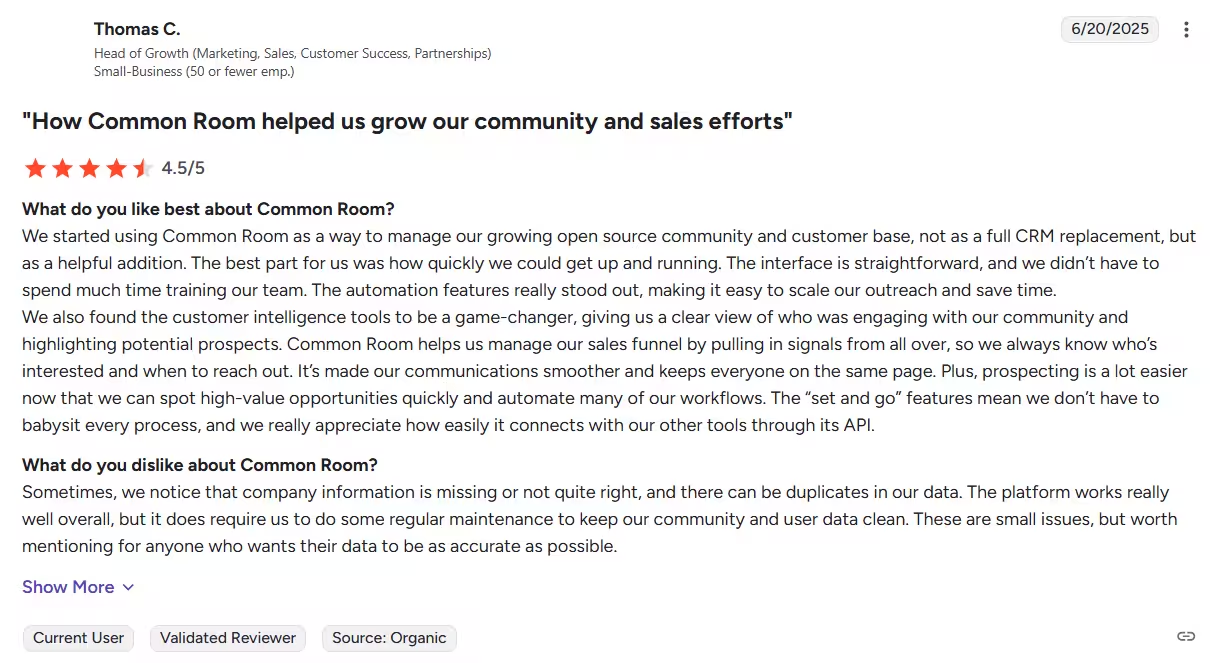
- Product Depth & Community Signal Integrations: For devtools, product adoption tends to be multi-dimensional— developer engagement can be captured through external community signals and in-product signals. For effective targeting, you need a tool that offers strong correlation between the two. That way, your DevRel team can identify key insights like which community members are adopting key features and which in-product behaviors might correspond to advocacy or expansion opportunities in external communities, and accordingly pass on this information to the sales team to prioritize outreach and upsell efforts. Common Room is a community-first signal intelligence platform, but if you want to bridge rich developer-centric first-party intent signals like CLI command interactions, Docker installs, and third-party intent signals like competitor GitHub repositories, firmographic and technographic data to name a few, users feel it can require extra setup or custom work, and you’d be better off with a tool that seamlessly ties in external signals directly to in-product behavior for a unified view on developer engagement.
- Pricing and Scalability: Common Room pricing has been a major blocker for small companies who might have been considering Common Room in the past. Devtool teams often start with small communities and tight budgets so the ideal tool scales from free/self-serve to heavier plans without forcing an immediate 5-figure commitment.
- Ease of Onboarding and Workflow Fit: No one wants a tool with a steep learning curve. The more intuitive the tool, the better it fits into the workflow of devtool teams
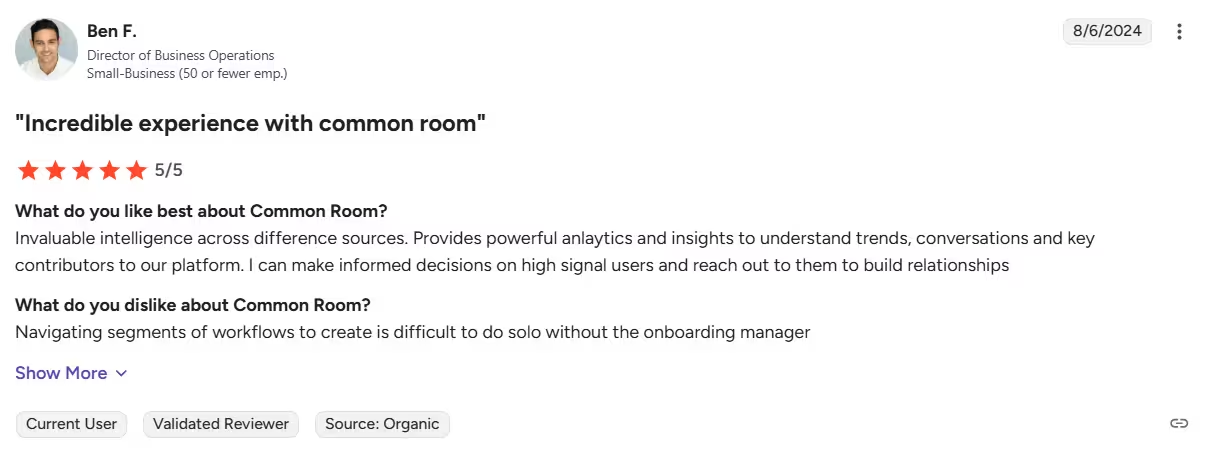
- Customization: Signals from product usage tend to be direct indicators of intent, engagement, or likelihood to convert down the line. Therefore, Developer tools might fancy the ability to prioritize in-product signals over community signals to inform outreach/nurture. Look for tools that offer product-weighted signal scoring.
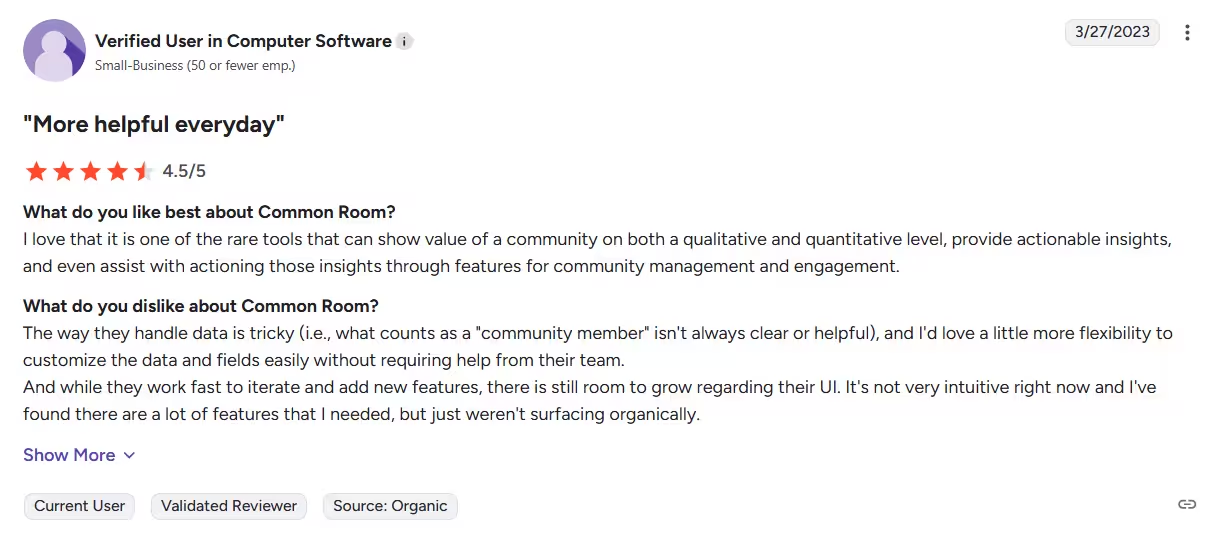
Best Common Room Alternatives
Reo.dev
Pros
- Data Accuracy and Account Mapping: Reo.dev prioritizes clean signal mapping from the start, giving it an advantage over Common Room. Reo.dev also allows users to flag incorrect data at the account level to ensure data reliability. It also emphasizes account-level enrichment based on developer behavior, allowing you to create custom intent-based segments to accurately identify practitioners, champions, and buyers with just a few clicks. Developer deanonymization is a major differentiator for Reo.dev boasting the world's largest and richest database of technical audience and their profiles, consisting of 25M+ people and 150M+ social profiles tracked. This allows Reo.dev to execute 3x better identity resolution than Common Room.

- Product Depth & Community Signal Integrations: Reo.dev’s “Developer Funnel” was built to help you aggregate developer activity across different developer-specific community channels like Reddit, Stack Exchange, Slack, Hacker News, and Dev.to to show exactly where accounts are in their buying stage, allowing you to step in at the right time.
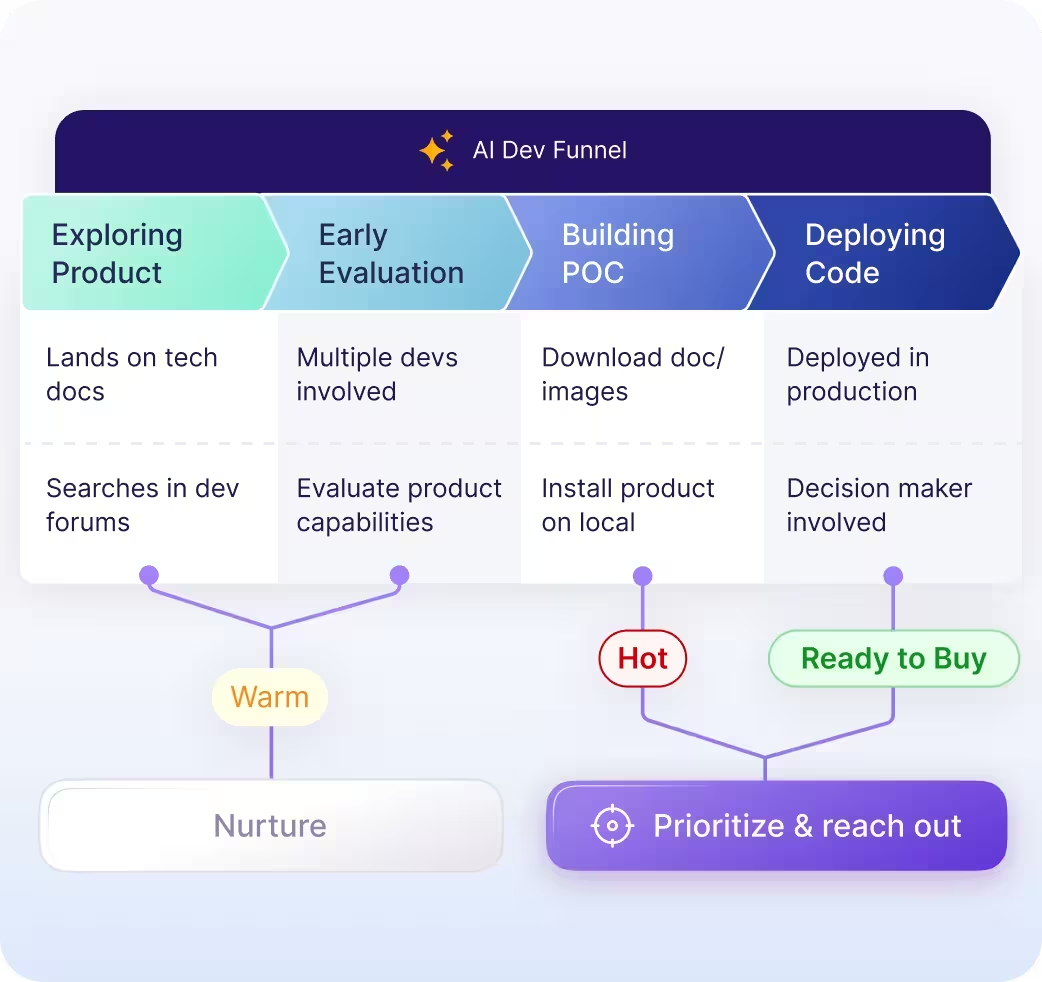
- Pricing and Scalability: Reo.dev’s pricing is designed for devtool companies at all stages. The pricing model offers lightweight entry point for startups while having a gentler scaling curve for more advanced use cases. Unlike some of the other tools on the list, you don’t get hit with an immediate “enterprise toll” simply because your community started growing.
- Ease of Onboarding and Workflow Fit: Reo.dev provides white-glove onboarding to its users, allowing them to go live in 1 week. Reo.dev’s TTV (Time-to-Value) averages less than a month, thanks to its signal flows which are preconfigured for devtool contexts.
- Customization: With Reo.dev, you can assign custom scores (on a scale of 0-10) to certain activity types like Documentation, GitHub, product, website, form interactions, code interactions, and communities. Based on your custom score weightage, Reo.dev’s AI model calculates the developer and account activity score giving you the flexibility to accurately define intent among your prospects. Users also get flexible dashboards with role-aware and account-aware views, making it easy for DevRel, Growth, and Sales teams to see all the segments they need. Advanced scoring and prioritization is further made easy with Reo.dev’s filters.
Cons
- Users have reported a slight learning curve, with the setup requiring help from Reo.dev’s team.
Best Use Case
Reo.dev is the perfect tool for developer-focused companies that sell to a technical audience who want to about capture product usage signals and correlate them with community signals, followed by routing them into automated GTM workflows for the best shot at converting ‘dark funnel’ leads.
Commsor
Pros
- Commsor is famously known for its GTN (Go-To Network) focus and provides helpful educational resources for a community-first motion.
- Community teams find the Commsor onboarding experience to be very smooth, and coupled with a highly intuitive UI and an active online DevRel community on Slack, it’s easy for established teams in mid-to-large scale organizations to start tracking key community signals.
Cons
- With pricing plans starting from $1K/month, Commsor is geared towards community teams at mid-to-large scale organizations. Early-stage developer tooling teams who’d like a self-serve plan to try out the product on their own might be better off with a different alternative.
- While Commsor provides you with a strong set of community signals across platforms like Discord, Slack, GitHub, Twitter/X, it doesn’t natively emphasize on tying those signals to product usage telemetry. This also means if you are looking for a tool that provides you with deeper product and account analytics that go beyond community health metrics, Commsor might not be the right fit for you.
- Commsor is ideal for tracking individual developer engagement on various community channels. However, users might find it less ideal to map practitioners to the relevant accounts and decision-makers/buyers by extension.
Best Use Case
Commsor is the ideal tool for mature community teams at devtool companies with larger budgets who prefer a polished community CRM to keep track of key events, champions, and engagement.
ZoomInfo
Pros
- ZoomInfo is well known for its comprehensive B2B database with 600M+ profiles captured and 1.5B+ data points processed daily.
- It provides users with rich intent and buying signal data across firmographic triggers, web activity, technographics, and demographic filters like titles and org charts. ZoomInfo also provides enterprise-grade reporting and analytics capabilities, allowing you to operate from a single source of truth, aligning sales and marketing to elevate GTM motions.
- ZoomInfo integrates with 60+ vendors, allowing you to support all your large and niche data needs from third and first-party sources. This comes in handy when you’d like to enrich your CRM with easy-to-configure enrichment workflows.
Cons
- In-product usage telemetry signals or developer-specific community signals are not ZoomInfo’s strong suit.
- Users might find ZoomInfo’s pricing to be pretty opaque, and with its enterprise sales focus, smaller devtool companies who need granular developer-to-account mapping might not find ZoomInfo ideal.
- Data inaccuracy is a commonly brought up drawback among ZoomInfo’s users, where outdated contact data could be a stumbling block, specifically for more niche industries.
Best Use Case
If you’re a devtool company that is transitioning into enterprise sales with a mature RevOps/sales/marketing stack, you’ll find ZoomInfo an ideal fit to enrich account data, map buying committees, and detect intent signals among enterprises.
Glowradius
Pros
- Glowradius integrates with GitHub and Reddit, making them a good tool to source user profiles, contributor data, and key discussions for a community-first GTM motion. At the same time, its integrations with HubSpot, Salesforce, and Salesloft provides you with company-level insights for community members.
- It provides agent-driven automation for key GTM workflows along with a massive library of GTM plays engineered by the GlowRadius team.
Cons
- Developer-level deanonymization is limited, which might make it a tough draw for DevRel teams. Additionally, community signals captured via Glowradius don’t seem to have a native correlation with in-product signals, further making it difficult to identify potential buyers.
- The onboarding might have a slight learning curve, especially for teams without dedicated technical resources.
- Pricing isn’t transparent, and while scalability might not be an issue, it still makes it a tough draw for a devtool company with a tight budget.
- In-product signals such as feature usage, session data seem to be missing, which further makes it difficult for devtool teams to accurately pinpoint buying intent, and might have to rely on integrating a tool that does provide these signals.
Best Use Case
Glowradius is a great tool for startups who are looking for an affordable way to centralize their Slack, Reddit, GitHub or other community signals without heavy setup.
6Sense
Pros
- 6Sense is pretty strong at account-level identity resolution, allowing users to enrich company-level data, intent, and engagement across multiple touchpoints.
- 6Sense provides very strong enterprise-grade dashboarding and reporting capabilities, allowing you to slice intent and pipeline data in various sophisticated ways.
Cons
- 6Sense struggles with deanonymizing developers across community platforms and CLI usage, its deanonymizing features are limited to website visits.
- 6Sense doesn’t have a deep integration with developer communities or with in-product telemetry, leaning strongly on marketing/sales focused signals like intent, ad engagement, and firmographic triggers making it unsuitable for DevRel-led GTM motions that want community and product usage visibility.
- Its pricing is opaque, but scales well for enterprise organizations. Lean developer teams might find 6Sense a little cost-prohibitive.
- According to users, the initial implementation and configuration may require significant time and effort to get everything working smoothly.
- Inaccurate data seems to be a common issue among some users, which might lead to outreach based incomplete or missing insights, rendering it ineffective.
Best Use Case
6Sense is a great tool for enterprise devtool companies who’d like to layer account-level buying data into their sales process.
Demandbase
Pros
- Demandbase provides users with a lot of customization power, but it’s skewed towards marketing/sales use cases.
- Demandbase provides users with key contact recommendations for buying group members from their extensive database which can be scored based on recency, data coverage, source reliability, popularity, and title. Besides their proprietary intent data, Demandbase also partners up with Bombora Surge for real-time updates, G2 intent for the BOFU (Bottom-Of-The-Funnel) buyer, TrustRadius intent for in-market buyers to provide you with key intent signals like company information that includes detailed firmographics, technographics, news, and social insights. This allows it to map practitioners to buyers pretty accurately, based on all these external channels.
Cons
- For a devtool company, Demandbase might seem like a tool that requires heavy setup and orchestration with Salesforce or Marketo-style stacks.
- Demandbase primarily caters to enterprises, and it’s reflected in their pricing model, which might seem like too big of a lift for an early-stage or mid-market developer tooling company.
- While Demandbase excels at proving account-based intent and marketing data, it lacks community and product usage signals, both of which are crucial for accurate buyer intent signalling.
Best Use Case
Demandbase is recommended for enterprise developer tooling companies with longer sales cycles for higher-ticket items and established marketing and sales teams who’d like to run ABM campaigns.
Bevy
Pros
- Bevy provides you with in-depth data around all event types, allowing you to track growth, incentivize key actions, and take data-based actions to improve event ROI. Therefore, if your GTM motion is community-event driven, Bevy is a strong workflow fit.
Cons
- Bevy isn’t a strong contender if person-level identity resolution is a priority for you, since Bevy isn’t built to help you deanonymize users across CLI, GitHub, Discord among other community channels. So, for in-product signals and external community signals, it’s recommended to opt for a different alternative.
- Bevy doesn’t provide a fixed pricing plan, but rather a pricing calculator to help you estimate how you can best use its offering. This might alienate small devtool startups that don’t already have an established community forum/platform, making it difficult for them to accurately estimate the cost.
Best Use Case
If your DevRel motion leans heavily on events like meetups, conferences, and hackathons are a primary growth lever (some examples of said events could be HashiConf or MongoDB World), Bevy is the ideal tool.
HockeyStack
Pros
- HockeyStack excels at providing identity resolution for in-product telemetry and buyer journeys across all touch points.
- HockeyStack provides users with a comprehensive dashboard for product analytics signals with customized filters, outreach flows, and messaging to correspond with each buyer’s unique journey.
- HockeyStack’s pricing is more flexible for mid-tier organizations with friendlier scaling per usage growth compared to more enterprise-friendly tools like Demandbase and 6Sense.
- Its lightweight onboarding process, combined with an extensive set of useful resources (blog, template, workflow, and prompt libraries, etc.) makes it a great fit for growth or product teams.
Cons
- HockeyStack lacks in developer community coverage, which can be a deal breaker for devtool companies especially invested in open-source communities.
- The pricing structure isn’t transparent which can be a blocker for startups looking to get started with in-product signal tracking.
Best Use Case
HockeyStack is perfect for devtools with a strong PLG motion that want to deeply understand product adoption funnels and tie them back to revenue.

